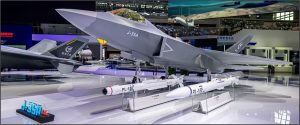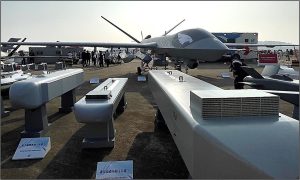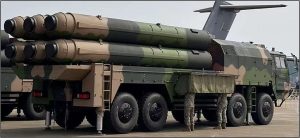
ZHUHAI AIRSHOW: SHOWCASING THE DRAGON’S MILITARY MIGHT!

The 15th China International Aviation and Aerospace Exhibition (CIAAE), also known as Airshow China, and the only international airshow in mainland China, was organised in Zhuhai city-prefecture in the coastal Guangdong Province in Southern China from 12th to 17th November 2024.
CIAAE-24 witnessed a footfall of over 600,000 visitors, 1022 exhibitors from 47 countries and over 150 global participant firms, signifying more than 100% increase in participation over the previous edition, held at the same venue in November 2022, and the largest since its inception in 1966. Various contracts inked during/after the show totalled close to an impressive US$ 40 billion.

15th CIAAE-2024: Source-gov.cn
An extensive static/flying display showcased China’s aerospace and military/civil aviation assets. These included a variety of prototypes/technology demonstrators and in-service aerial platforms/vectors. This article will restrict itself to the description of some of the major military equipment displayed, as enunciated hereinafter.


Chengdu J-10 Fighter Aircraft of China’s Bayi Aerobatic Team and Su-35S Fighters of the Russian Knights Aerobatic Team Perform at CIAAE-24: Source-english.news.cn/theaviationist.com
Shenyang J-35
The Shenyang J-35 Stealth Multi-Role Combat Aircraft (MRCA) was undeniably the flagship exhibit at CIAAE-24. The Fifth-Generation Fighter Aircraft (FGFA) is designed for stealth air-superiority and surface-strike missions. It has been developed from its predecessor, the Shenyang FC-31 Gyrfalcon -a stealth FGFA prototype and export-oriented technology demonstrator in development since the last decade. The J-35 reportedly has been produced in two variants: a land-based variant of the PLAAF and an aircraft carrier (AC)-based variant for the PLA Navy (PLAN), the latter optimised for a Catapult Assisted Take-Off but Arrested Recovery (CATOBAR) configuration.
While many comparisons have been made to the US F-35 Lightning-II FGFA, the J-35 is visually distinct in that it has a twin-engine powerpack and a visibly leaner, more chined (sharp-edged) fuselage. The F-35 is considered superior in stealth coating, radar-evading materials, multi-sensor data fusion (MSDF) and data processing technologies. The J-35 design, for stealth, incorporates engine blades hidden by serpentine inlets (S-ducts) behind divert-less supersonic inlet (DSI) bumps, which obscure the reflective surface of the engine from radar detection. The airframe and its internal weapons bay, compartment doors, and embedded antennae are lined with sawtooth edges and covered with Radar-Absorbent Material (RAM) coating. It has a maximum speed of Mach-1.8, service-ceiling of 52,000 feet, combat-range of 1200-1250 Km on internal fuel, max take-off weight (MTOW) of about 28,000 Kg, internal weapons bay and an option of six additional underwing hardpoints, if stealth is forsaken. The powerpack has two Guizhou Afterburning Turbofan Engines (ATE), generating approximately 93-116 kN of thrust (depending on the variant), with afterburner. It mounts the Chinese KLJ-7A AESA Radar, with a range of about 200 Km for an aircraft of Radar Cross-Section (RCS) 5m2 (equal to that of the US F16). The J-35 also mounts a Distributed Aperture System (DAS) Optical Early-Warning (EW) system, an Electro-Optical (EO) Targeting System (EOTS), helmet-mounted display and Infra-Red (IR) Search-and-Track (IRST).
The maritime version of the J-35 will likely see service aboard the first Type 003 Class AC of the PLAN-the Fujian. The PLAAF version of the J-35 made its first successful test-flight on 29 September 2023. The land-based PLA Air Force (PLAAF) variant, compared to the maritime-version, sports a smaller wing surface area, single nose wheel, and non-clipped wings. A full-size mock-up of the maritime-version was spotted onboard the PLAN aircraft carrier Liaoning on 13 February this year, probably as part of evaluation as a deck-based fighter.

J-35A at CIAAE-24: Source- global.chinadaily.com.cn

Visual Comparison Between the J-35A (Top) and the F-35 A (Bottom): Source-theaviationist.com

Visual Comparison Between the J-35A (Top) and the FC-31 Gyrfalcon: Source-x.com/LogKa1
Note: –1. The differences are based on the creator’s visual perception and are not officially corroborated.
2. Luneberg Lens are mounted to increase visibility/hide true RCS during training/routine flights
Chengdu J-20
The Chengdu J-20 Mighty Dragon is a twin-engine all-weather FGFA developed by China’s Chengdu Aerospace Corporation for the PLAAF. The J-20 is designed as a stealth air-superiority fighter with precision-strike capability. The aircraft has three notable variants: the initial production model (2011), the revised airframe variant with new engines and thrust-vectoring control (TVC) (2020), and the MUMT-capable tandem-seat variant: J-20S (November 2024). It is the only FGFA presently in production with supercruise capability, along with the Russian Su-57.
The stealth features of the J-20 include a chiselled nose-section and a frameless, electroconductive canopy, a long, blended, bottom-flat fuselage, RAM coating, low-observable DSI intakes obscuring the engines’ reflecting surfaces, two internal weapons bays and leading-edge extensions merging into the delta-wing with forward-swept trailing edges. The aft section has low-observable serrated engine exhausts. All these give the J-20 an approximate RCS of 0.26 m2 at 5GHz, as opposed to 0.7 m2 for the Su-57!
The J-20 is powered by two Shenyang WS-10C ATE, generating 142 kN of thrust. The canard design provides tighter turning radius, good supersonic performance with greater lift, and improved STOL capability, compared to the conventional delta-wing design. The J-20 is capable of MSDF with multi-spectral sensors, mounts an AESA Radar with 200 Km range and multi-target tracking/engagement capability, EOTS, IRST and four underwing pylons. Additionally, the frameless canopy, extensive flight-control surfaces and canard configuration provide the capability for interceptor roles. The J-20 thus apparently shows greater optimisation than the F-35 for visual-range engagements! Similar in dimensions to the F-22, the J-20 has a top speed of Mach-2.0, MTOW of 37,000Kg, combat-range of 2000 Km with internal fuel and service-ceiling of 65,620 feet.
Various publications have opined that the J-20’s stealth is inferior overall to the US F-35, especially in the rear aspect. The J-20 reportedly entered service with the PLAAF in March 2017. A shortened version might see induction aboard Type 003 AC. In October 2022, Chinese media showcased MUMT between a J-20S and a GJ-11 stealth drone (read more @ https://chanakyaforum.com/stealth-drones-ninjas-of-the-modern-battlespace/).

J-20S Tandem-Seater at CIAAE-24: Source-global.chinadaily.com.cn


J-20 In Flight:Source-airliners.net/militarywatchmagazine.com
Su-57 FGFA
As an indicator of an emerging ‘Eastern Bloc’ Alliance, Sukhoi’s twin-engine Su-57 FGFA, Russia’s most advanced stealth-fighter in production, was displayed at CIAAE-24. It is the product of the PAK FA (Prospective Aeronautical Complex of Front-line Aviation) Program, which was initiated in 1999 as a modern/affordable alternative to the Mikoyan Project.
The FGFA incorporates stealth, super-manoeuverability (capability to execute extreme tactical manoeuvers) aided by TVC, supercruise at Mach-1.3 (sustained supersonic-flight without using afterburners), integrated avionics and large payload capacity. The aircraft has a supersonic range of over 1500 Km. Similar to other stealth fighters such as the F-22, the aircraft sports planform edges, internal weapons bays and RAM-coating to reduce its RCS. The leading/trailing edges of the wings/control-surfaces and the serrated edges of skin panels are carefully angled to reduce radar-wave deflection. Antennae are recessed from the fuselage to preserve the aircraft’s stealthy shape. The Su-57’s design emphasizes frontal stealth, with RCS-reducing features most apparent in the forward section. The shaping of the aft fuselage is less optimized for radar stealth, resulting in inferior overall RCS when compared to the F-22/F-35/J-20.
The aircraft is powered by two Lyulka-Saturn ATE, generating 142.2 kN of thrust with afterburners. It has a MTOW of 35,000 Kg, maximum speed of Mach-2, combat-range of 1250 Km with internal fuel, and service-ceiling of 66,000 feet.
The Su-57 Felon displayed its fourth prototype, the T-50-4 ‘054 Blue’ at Zhuhai. This overseas debut of the Su-57 unambiguously suggested the present close military cooperation between China and Russia.

Russian Su-57 FGFA During Flying Display at CIAAE-24: Source-edition.cnn.com
J-15T Carrier-Based Fighter (CBF) and J-15D EW Fighter
The PLAN unveiled the twin-engine J-15T Flying Shark CBF at CIAAE-24. This Naval variant of the J-15 is an upgraded 4.5 Generation Fighter with an advanced AESA Radar. It mounts two Shenyang WS-10A/B ATE, generating 120-144 kN of thrust. The CBF is compatible with the CATOBAR launch system in the Type 003 ACs. The CBF also participated in drills with the STOBAR-fitted Liaoning and Shandong ACs in the South China Sea in October 2024, thus underscoring its versatility. The J-15T has a significantly robust/re-engineered twin-wheel nose-landing gear equipped with a catapult launch bar-thus tailormade to absorb the stresses of a CATOBAR launch. The aircraft can mount the PL-10/PL-15 air-to-air missiles (AAM) and is capable of undertaking SEAD operations. It has a MTOW of 32,500 Kg, Max speed of Mach-2.15, combat-range of 1270 Km and service-ceiling of 56,000 feet.
The J-15D CBF is an EW variant of the J-15T for AC-based operations, combining strike and EW roles. It is similar in role to the US Boeing EA-18G Growler. The tandem-seat aircraft mounts EW pods/associated EW equipment. The J-15D co-participated with the J-15T in the above sea drills last month.
The Shenyang 4.5 Generation J-16 multirole strike fighter, a tandem-seat variant based on the 4th Generation J-11BS, and an advanced derivative of the Russian Flanker series was also displayed. The J-16 is equipped with an AESA radar and is powered by two WS-10A engines. Weight reduction is achieved through greater use of composite materials, while RAM paint has been used to reduce RCS. The aircraft has enhanced SEAD and electronic support capability.



J-15T CBF, J-15D EW Fighter and J-16 Multirole Fighter at Zhuhai:
Source-globaltimes.cn/janes.com
Y-20 Heavy Lift Transport Aircraft (HLTA)
The Y-20 Kunpeng, manufactured by Xi’an Aircraft Industrial Corporation, is China’s new-generation large, multi-role military transport aircraft. It features long-range and high load-capacity, enabling it to conduct long-distance strategic airlift missions. It is the only strategic-lift transport aircraft that is presently in production globally. The YY-20 aerial refueller variant of the Y-20, made its first public appearance at Zhuhai in November 2022. The HLTA was displayed for the first time outside China at the Egypt International Airshow in September 2024 (read more about the Y-20 @ https://chanakyaforum.com/egypt-international-airshow-september-2024/ ).

YY-20 Tanker Aircraft During Flying Display at CIAAE-24: Source-gov.cn
(Note the Refuelling Hoses/Drogues)
Unmanned Systems
CIAAE-24 introduced a dedicated exhibition area for unmanned systems for the first time, featuring the latest advancements in Unmanned Aerial Vehicles (UAVs) and unmanned ships.
Jetank Drone Mothership. State-owned Aviation Industry Corporation of China (AVIC) unveiled a massive satellite-enabled, remotely piloted swarm drone-carrier ‘mothership’ UCAV, powered by a single dorsal-mounted turbofan engine that can carry a payload of up to six tons. The Jetank, with retractable landing-gear, has a wingspan of 25 meters and a MTOW of 16 tons, making it among the largest such UAVs in China’s arsenal. The drone boasts eight hardpoints for weapons and a “mission-module” that can be configured for a range of functions, including airlift/airdrop/strike/ support and deployment of electronic countermeasures. The Jetank was showcased with a range of weapon-systems, including laser-guided/glide bombs, and anti-ship missiles/AAM. The UCAV can also house a replaceable ‘isomerism hive module’- a specialised compartment for carrying smaller, AI-enabled drones which can undertake recce/strike/communications relay and EW missions.

Jetank Swarm Drone Carrier at CIAAE-24: Source-flightglobal.com
Wing Loong-X UCAV
AVIC’s Wing Loong-X UCAV is a medium-altitude, long-endurance (MALE) UAV with advanced anti-surface/anti-submarine capabilities and is presently undergoing flight-tests. The drone can conduct missions such as reconnaissance/surveillance over large maritime spaces, comprehensive submarine search-and-attack, maritime-escort, maritime-rescue and long-range aerial patrols. At the airshow, the UCAV was displayed with four sono-buoy dispenser pods, an ET-60 (export-version) anti-submarine lightweight electric-propulsion torpedo, two PL-108 Lite AAMs, and a YJ-9E lightweight anti-ship missile, on its eight underwing hardpoints. Other weapons displayed included PL-12/PL-10 AAMs, an LD-8A Anti-Radiation Missile, a CM-400AKG Anti-Ship Missile, and LS-6 250 kg/500 kg Precision-Guided Munitions. The UCAV can also be equipped with EW/COMINT/SIGINT pods. With a reported ceiling of 32,000 feet and an endurance of 40 hours, it is reportedly China’s largest and heaviest armed unmanned reconnaissance/strike platform.
The Wing-Loong 6 multirole MALE UAV was also displayed alongside.

Wing Loong-X UAV With Payloads at CIAAE-24: Source-globaltimes.cn
MD-22 Hypersonic Drone. A mock-up of the MD-22 hypersonic technology-demonstrator was displayed at CIAAE-24. The accompanying description states that the MD-22 is a reusable near-space test-platform, with a maximum speed of Mach-7, and is capable of rocket-assisted/ autonomous take-off. The drone has a MTOW of 4000 Kg and a range of 8000 Km, the latter giving it intercontinental strike capability.

MD-22 Hypersonic Drone: Source- gagadget.com
CH-7 Stealth UCAV. China Aerospace Science and Technology Corporation (CASC) displayed the CH-7 Rainbow Stealth UCAV- designed to undertake ISR/strike missions. Read more about the CH-7 @ https://chanakyaforum.com/stealth-drones-ninjas-of-the-modern-battlespace/ ).

CH-7 Stealth Drone at CIAAE-24: Source-usnews.com
Orca USV. The airshow featured the global debut of China’s large Unmanned Surface Vessel (USV), the JARI-USV-A, or the Orca, not be confused with a similar US craft of the same name. Measuring 58 meters in length, the 500-tonne stealth-USV boasts a maximum speed of 74 Kmph, with a range of just under 7500 Km. It also boasts an aft helideck for multiple unmanned rotorcraft. The USV can carry diverse payloads for beyond-visual-range (BVR) strikes, AD and anti-missile operations. The stern features a large opening, which allows optional installation of active/passive towed sonar arrays for submarine detection, and the ability to deploy sono-buoys and anti-submarine torpedoes. The USV’s combat bridge houses a large four-cell Vertical Launch System (VLS), identified as the HT-1 universal VLS, allowing for hot/cold missile-launch configurations. It can also be equipped with various search and detection systems, including AESA radar, EO/IR sensors, radar and SONAR. The Orca thus possesses anti-submarine and offshore-strike capability. Built with stealth as a priority, the USV boasts advanced radar-wave stealth features and diesel-electric dual-mode propulsion, significantly reducing detectability.

China’s USV Orca at CIAAE-24: Source-news.cgtn.com/armyrecognition.com
HQ-19 Anti-Ballistic Missile System (ABMS)
China unveiled the Hongqi-19 (HQ-19) ABMS at CIAAE-24. Mounted on an 8×8 high-mobility vehicle, the HQ-19 carries six exo-atmospheric kinetic-kill interceptor missiles (akin to the US THAAD) with a “cold-launch” mechanism, allowing rapid deployment of ABMs. The ABMS is also reportedly capable of intercepting hypersonic glide-vehicles in the atmosphere. The ABMS’ radar configuration, including the 610A Information Radar, can reportedly detect targets at ranges up to 4,000 Km, allowing it to cover areas from Northern South Asia to the Tibetan Autonomous Region. The IR-guided interceptor is powered by a two-stage, solid-propellant rocket motor providing high specific-impulse and greater manoeuverability. Along with its Target Designation Radar, this enables interception of endo/exo-atmospheric warheads and re-entry vehicles at ranges up to 3000 Km and altitudes of 200 Km, at speeds of upto Mach-29.

HQ-19 ABMS: Source- armyrecognition.com
PL-15E AAM
China also unveiled a new version of its PL-15 long-range AAM at CIAAE-24. The AAM mounts folding tailfins, a design that allows for more compact stowage to fit China’s FGFAs. The AAM has a range of 200 Km and a speed of Mach-5. It is often compared to the US AIM-120 Advanced Medium-Range AAM.

Scaled Model of PL-15E AAM at CIAAE-24: Source-edition.cnn.com
Conclusion
While complete coverage of the exhaustive static/flying displays at CIAAE-24 and strategic ramifications of operational deployment of these platforms is beyond the scope of this article, a world-beating profile of aerial/stealth platforms was evident. China’s unambiguous push to become world-leaders in cutting-edge stealth/unmanned technology was apparent at Zhuhai-24.
Cover Image:
Source-gov.cn/pngegg.com
Disclaimer
The opinions expressed in this article are the author’s own and do not reflect the views of Chanakya Forum. All information provided in this article including timeliness, completeness, accuracy, suitability or validity of information referenced therein, is the sole responsibility of the author. www.chanakyaforum.com does not assume any responsibility for the same.
Chanakya Forum is now on . Click here to join our channel (@ChanakyaForum) and stay updated with the latest headlines and articles.
Important
We work round the clock to bring you the finest articles and updates from around the world. There is a team that works tirelessly to ensure that you have a seamless reading experience. But all this costs money. Please support us so that we keep doing what we do best. Happy Reading
Support Us





















POST COMMENTS (0)